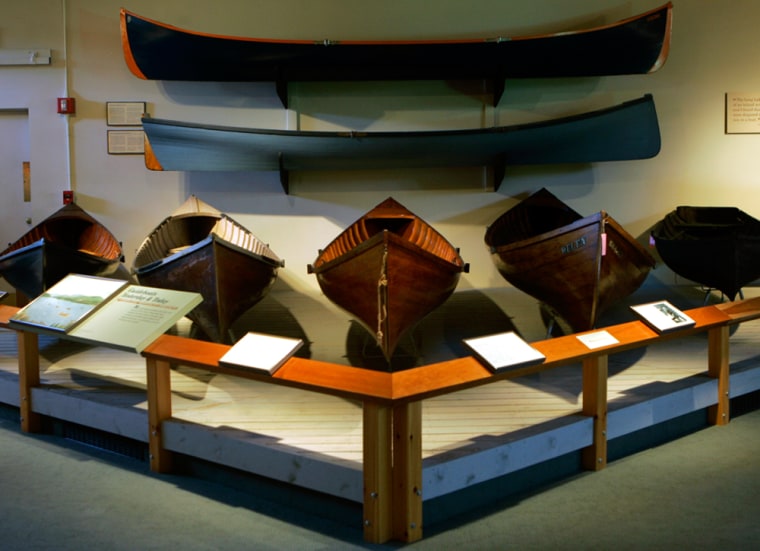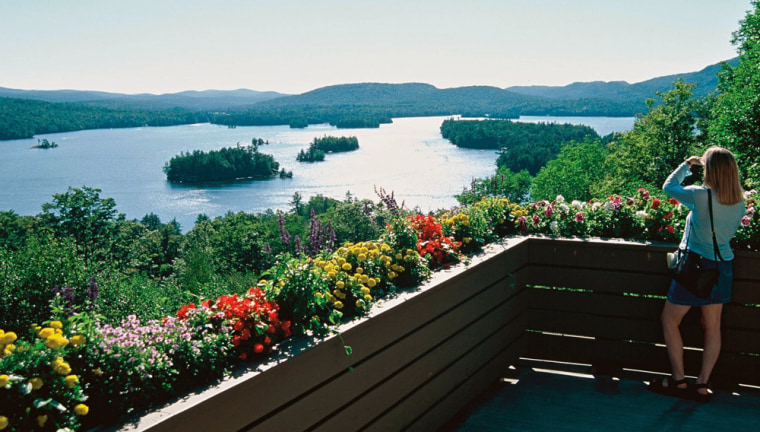When mining magnate Harold Hochschild bought the Blue Mountain House resort in the middle of the last century, his vision was to create a place that would forever preserve the heritage of the Adirondacks.
Overlooking picturesque Blue Mountain Lake, Hochschild opened a modest museum in 1957 to celebrate the people of Adirondacks — how they lived, worked and played. This year, the Adirondack Museum celebrates its 50th season. But it's no longer just a roadside curiosity. Its gardens, scenic views, events and activities make it a worthy destination for a day — or two — spent wandering the grounds.
"Nobody can believe it's as big as it is, and they are always surprised that it takes them all day to see it, rather than the half-hour they thought," said museum director Caroline Welsh.
The museum has grown from nine buildings to 22, including a 19th century logger's hotel, an artist's cottage, a one-room cabin called the Sunset Cottage, a 1907 one-room school house that now serves as a family activity center, a fire tower, and the Marion River Carry Pavilion, which houses a 1901 steam engine and passenger car and a steamboat called the "Osprey". Each building, Welsh noted, is like its own small museum.
Last year, more than 90,000 visitors viewed the 32-acre museum's collections and exhibits on logging, boats and boating, mining, outdoor recreation, transportation and rustic furniture.
Visitors can tour the extensive grounds and gardens, ride a vintage Adirondack skiff on the boat pond, and dine in the glass-walled museum cafe, which offers "spectacular views of Blue Mountain Lake from halfway up the mountain," Welsh said.
Or get your lunch from the cafe to go, and head to one of the designated picnic spots around the grounds. For families, there are activities like "sap to syrup" and "wash day," where kids can run clothes through an old-fashioned wringer. Programs geared to adults include lectures and demonstrations such as how to make a canoe paddle or a classic Adirondack chair.
The museum's holdings represent the single largest collection of Adirondack material, including over 2,500 original artworks, 70,000 photographs and 300 freshwater boats and wheeled vehicles, including the carriage that rushed vacationing Vice President Theodore Roosevelt to the train the night President William McKinley was assassinated.
"Without a doubt, for all of its 50 years, the Adirondack Museum has been one of the premier attractions of the region. I've heard visitors refer to it as the `Smithsonian of the Adirondacks,'" said Adirondack Regional Tourism Council Director Ann Melious.

Hochschild was for many years the executive head of the American Metals Company, which eventually became AMAX Inc. As a child, Hochschild spent the summers with his family in nearby Eagle Nest and grew fond of the mountains and countless lakes. He would eventually write several history books of his own about the Adirondacks.
In the 1940s, local residents approached Hochschild about buying and preserving the engine and passenger car now displayed in the Marion River Carry Pavilion.
The engine and car had been left rusting in the woods after 75 years of use, said Welsh. But between 1901 and 1929, the train was famous as the country's shortest standard-gauge line railroad, carrying vacationers 1,300 yards from the station in Raquette Lake to pick up steamboats on adjacent Utowana, Eagle and Blue Mountain lakes. The engine and passenger car are still on display.
That crusade led to Hochschild purchasing the property of the former hotel, which had been started by enterprising loggers in 1876 and operated into the 1940s before shutting down. The Log Hotel, once the resort's main building, is now one of the exhibits, and is on the National Register of Historic Places.
The museum opened to the public on Aug. 4, 1957, funded by the Hochschild Foundation. In the early 1980s, it became an independent, not-for-profit museum with its own endowment made up of money from the foundation and fundraising. The Hochschild family has remained involved.
The museum has grown steadily over the years with construction and acquisition spurts, including the acquisition of the one-room school house and a log hunting camp. The last decade has focused on adding more participatory and interactive exhibits, Welsh said.
Over the next 10 years, the museum has plans to revitalize many long-term exhibits.
It also has preliminary plans to open a satellite museum in Lake Placid, in the heart of the Adirondacks' High Peaks region. If plans are successful, it will open sometime in 2009. The satellite museum would be open year-round; the main museum is open for only five months a year.
For its 50th anniversary, the museum has four new exhibits that highlight Adirondack rustic traditions in furniture, art and architecture, as well as a special exhibit devoted to Hochschild and the museum's history.
